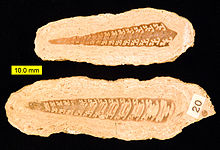Oncolites are sedimentary structures composed of oncoids, which are layered structures formed by cyanobacterial growth. Oncolites are very similar to stromatolites, but, instead of forming columns, they form approximately spherical structures.[1] The oncoids often form around a central nucleus, such as a shell fragment,[2] and a calcium carbonate structure is deposited by encrusting microbes. Oncolites are indicators of warm waters in the photic zone, but are also known in contemporary freshwater environments.[3] These structures rarely exceed 10 cm in diameter.


The appearance of recent/subrecent freshwater oncoids has been documented in two rivers in Bavaria: the Alz, whose source is the Chiemsee, and the Moosach, near Freising.[4][5][6]
Oncolites may have either a porostromate or spongiostromate texture. Most oncolites are spongiostromate, having no recognisable cellular texture or microstructure. Porostromate oncolites are mostly unknown during the Precambrian; since the Eocene they have mostly been confined to freshwater environments. [7]
| This article uses material from the Wikipedia article Metasyntactic variable, which is released under the Creative Commons Attribution-ShareAlike 3.0 Unported License. |